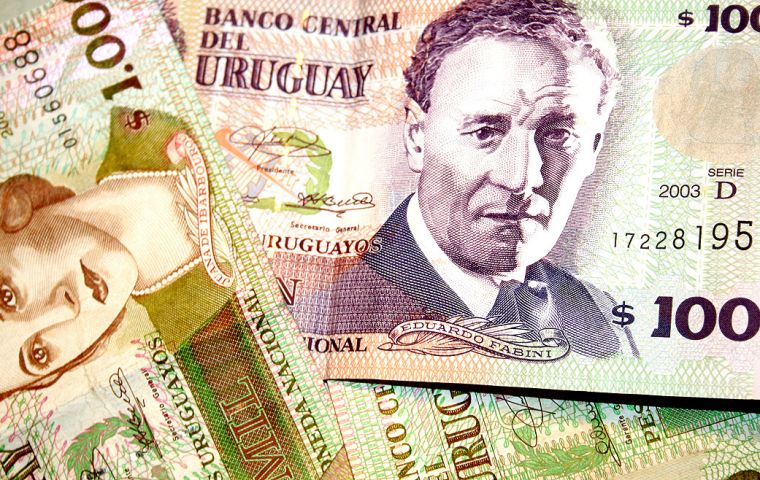MercoPress. South Atlantic News Agency
Uruguayan peso keeps growing against US dollar
 When measured in US dollars, internal costs in Uruguay are also on the rise: utilities, labor, taxes, and freight
When measured in US dollars, internal costs in Uruguay are also on the rise: utilities, labor, taxes, and freight While the Argentine peso keeps losing ground against the US dollar, just the opposite is going on across the River Plate, where the Uruguayan currency is stronger every day, having undergone a 12.4% appreciation so far this year.
The positive sign, however, is causing concern among Uruguayan traders who rely on Argentines traveling and spending money in the country with hotels still struggling to recover from the restrictive measures enforced during the COVID-19 pandemic.
The Uruguayan peso is one of the best-performing currencies in the region. After a UY$ 44.61 / US$ 1 parity at the beginning of the year, it stands now at UY$ 39.07 / US$ 1 at a time when international food prices have increased as a result of the war in Ukraine. Still, exporters have compensated for the fall of the dollar with higher prices for each product.
”Agribusiness has a much more favorable export price behavior than the rest of the industrial sectors, such as chemicals, auto parts, pharmaceuticals, vehicles, leather (despite being in the agribusiness sector), and plastics. These are the ones that suffer the most from the fall in the exchange rate,” Chamber of Industries (CIU) advisor Sebastián Pérez told El País.
María Laura Rodríguez, head of the economic, communication, and environmental consultancy of the Exporters Union recognizes that the agro-industrial sector has been favored by the rise in international prices, but she points out that it is also negatively impacted by the purchase of inputs, such as fertilizers. “In reality, the fall of the dollar does not favor the industry, the concern is for everyone,” she stressed.
“Prices are so good that agro-industrial exporters have no problems. We are breaking export records, that is undeniable. In the case of rice, we also had a historically very good harvest,” Centro de Estudios para el Desarrollo (CED) Agustín Iturralde was quoted as saying.
But Rodriguez insisted that “we must be careful because there are companies in the country that do not have the backbone to withstand such a significant and persistent fall in the dollar. As an association, we are warning: this harms many exporters. It would not be the first time it happens, and then we regret it.”
When measured in US dollars, internal costs in Uruguay are also on the rise: utilities, labor, taxes, and freight.
“A low dollar encourages the consumption of imported goods,” Iturralde said. It also “helps those who have debts in dollars and are pay them back in pesos,” he added, while noting that the current scenario favored Uruguayan workers on a salary to purchase household appliances, change the car, [or] take a trip,“ while ”food and energy prices in the local market would be even higher if they were to suffer the rise in the value of the dollar,“ said Iturralde, who also pointed out that ”Uruguay's monetary policy is still weak.“
The trend in South America is ”the appreciation of local currencies; perhaps in Uruguay, with a little more strength,“ he insisted. ”It is not that the dollar is going down, but that the Uruguayan peso going up.“
In Pérez's view ”the volatility of the exchange rate in Uruguay is due to the productive structure we have, which is very dedicated to the primary and agro-industrial sectors, and having such volatile export prices generates a volatile exchange rate.“
Iturralde insisted a ”small and open“ economy like Uruguay's needed a floating exchange rate, while ”in the fight against inflation, the increase in rates that seeks to contain inflation, does not deepen the fall of the dollar.”
There is consensus among analysts that some stability regarding the US dollar is to be expected in the coming months, perhaps at UY$ 42 / US$ 1, according to the Survey of Economic Expectations released Tuesday by the Uruguayan Central Bank (BCU).




Top Comments
Disclaimer & comment rulesCommenting for this story is now closed.
If you have a Facebook account, become a fan and comment on our Facebook Page!